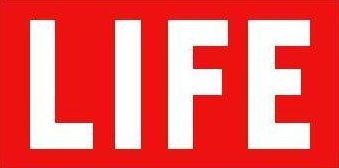| Vol. 12, No. 17 |

|
April 27, 1942 |
 CHIANG KAI-SHEK AND MAHATMA GANDHI, LEADERS OF ONE-THIRD OF WORLD'S PEOPLE, MEET IN CALCUTTA.
MODEL OF SHIP ON WHICH HOST ONCE SAILED STANDS IN BOOKCASE.
CHIANG KAI-SHEK AND MAHATMA GANDHI, LEADERS OF ONE-THIRD OF WORLD'S PEOPLE, MEET IN CALCUTTA.
MODEL OF SHIP ON WHICH HOST ONCE SAILED STANDS IN BOOKCASE.
|


|
Gandhi looks like an Asiatic but he is really a Hindu lawyer from South Africa. Like all India's Hindu leaders, he is loaded to the eyebrows with the patter of English university education. His idea of being foxy today is to wait to see whether or not this war abolishes the British Empire. He was therefore opposed to coming to any agreement whatsoever with an Empire that may possibly be on the skids. To Chiang Kai-shek, the short-spoken man of action, this brand of thinking was blankly mysterious, but he was exceedingly polite to all India's leaders.
The proposition brought to India a month later by Sir Stafford Cripps was that India would become a Dominion after the war, united or disunited as its separate parts decided for themselves. After much talk, Gandhi and Jawaharlal Nehru, the Congress Party, the Moslem League and the Untouchables all rejected this proposal, all for totally different reasons. Britain thereupon withdrew its offer. The comment of Nehru was typically that of an Indian leader: "Sir Stafford took the attitude, peculiar to the British, that they are always in the right, and the other is always wrong and damnably wrong." he therefore decided that Indians will not be among the men who make the peace, but that India will wait to petition the winner. Nehru and Cripps aged visibly during the talks under a full moon within smell of rose gardens. Gandhi remained calm. And Chiang Kai-shek went home without change of expression.
Actually India ceased being productively important about a century ago when the machine made its handicraft economically obsolete. In electric energy - the modern world's gauge of industrial power - India is about on a par with the State of South Carolina. Skipped by the industrial revolution, its 390,000,000 people have been largely reduced to the meanest level of agricultural sustenance. Only about 1% of this population is really represented by the Hindu leaders. Most of the rest of India do not know the name of Nehru, perhaps not even the name of Gandhi.
These are the people who will presently meet the Jap, unless Chiang Kai-shek's troops under American General Stilwell can stop that common enemy in Burma. The two contrary ways of meeting destiny have probably never been better symbolized than by the two men above. Gandhi has decided to leave India the football of destiny. Chiang long ago decided that China would and could make its own destiny.
It is significant that the pictures on this page of Chiang Kai-shek and Madame Chiang in India were all taken in the house of India's greatest capitalist.
Gandhi's chief backer, a man willing to do business with anybody.
It is hard to imagine what China's Generalissimo, hardened by awful sacrifice and heroism, made of this soft world of the Indians.
|


Adapted by Carl W. Weidenburner from the April 27, 1942 issue of LIFE Portions copyright 1942 Time, Inc. FOR PRIVATE NON-COMMERCIAL HISTORICAL REFERENCE ONLY TOP OF PAGE ABOUT THIS PAGE MORE CBI FROM LIFE MAGAZINE CLOSE THIS WINDOW VISITORS |